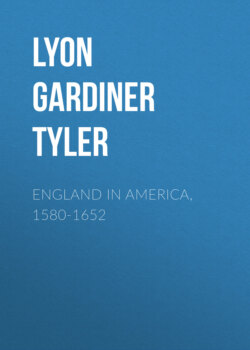Читать книгу England in America, 1580-1652 - Lyon Gardiner Tyler - Страница 4
На сайте Литреса книга снята с продажи.
EDITOR'S INTRODUCTION
ОглавлениеTable of Contents
Some space has already been given in this series to the English and their relation to the New World, especially the latter half of Cheyney's European Background of American History, which deals with the religious, social, and political institutions which the English colonists brought with them; and chapter v. of Bourne's Spain in America, describing the Cabot voyages. This volume begins a detailed story of the English settlement, and its title indicates the conception of the author that during the first half-century the American colonies were simply outlying portions of the English nation, but that owing to disturbances culminating in civil war they had the opportunity to develop on lines not suggested by the home government.
The first two chapters deal with the unsuccessful attempts to plant English colonies, especially by Gilbert and Raleigh. These beginnings are important because they proved the difficulty of planting colonies through individual enterprise. At the same time the author brings out clearly the various motives for colonization—the spirit of adventure, the desire to enjoy a new life, and the intent to harm the commerce of the colonies of Spain.
In chapters iii. to vi. the author describes the final founding of the first successful colony, Virginia, and emphasizes four notable characteristics of that movement. The first is the creation of colonizing companies (a part of the movement described in its more general features by Cheyney in his chapters vii. and viii.). The second is the great waste of money and the awful sacrifice of human life caused by the failure of the colonizers to adapt themselves to the conditions of life in America. That the people of Virginia should be fed on grain brought from England, should build their houses in a swamp, should spend their feeble energies in military executions of one another is an unhappy story made none the pleasanter by the knowledge that the founders of the company in England were spending freely of their substance and their effort on the colony. The third element in the growth of Virginia is the introduction of the staple crop, always in demand, and adapted to the soil of Virginia. Tobacco, after 1616, speedily became the main interest of Virginia, and without tobacco it must have gone down. A fourth characteristic is the early evidence of an unconquerable desire for self-government, brought out in the movements of the first assembly of 1619 and the later colonial government: here we have the germ of the later American system of government.
The founding of the neighboring colony of Maryland (chapters vii. and viii.) marks the first of the proprietary colonies; it followed by twenty-five years and had the advantage of the unhappy experience of Virginia and of very capable management. The author shows how little Maryland deserves the name of a Catholic colony, and he develops the Kent Island episode, the first serious boundary controversy between two English commonwealths in America.
To the two earliest New England colonies are devoted five chapters (ix. to xiii.), which are treated not as a separate episode but as part of the general spirit of colonization. Especial attention is paid to the development of popular government in Massachusetts, where the relation between governor, council, and freemen had an opportunity to work itself out. Through the transfer of the charter to New England, America had its first experience of a plantation with a written constitution for internal affairs. The fathers of the Puritan republics are further relieved of the halo which generations of venerating descendants have bestowed upon them, and appear as human characters. Though engaging in a great and difficult task, and while solving many problems, they nevertheless denied their own fundamental precept of the right of a man to worship God according to the dictates of his own conscience.
Chapters xiv. to xvi. describe the foundation of the little settlements in Connecticut, Rhode Island, New Haven, New Hampshire, and Maine; and here we have an interesting picture of little towns for a time standing quite independent, and gradually consolidating into commonwealths, or coalescing with more powerful neighbors. Then follow (chapters xvii. and xviii.) the international and intercolonial relations of the colonies, and especially the New England Confederation, the first form of American federal government.
A brief sketch of the conditions of social life in New England (chapter xix.) brings out the strong commercial spirit of the people as well as their intense religious life and the narrowness of their social and intellectual status. The bibliographical essay is necessarily a selection from the great literature of early English colonization, but is a conspectus of the most important secondary works and collections of sources.
The aim of the volume is to show the reasons for as well as the progress of English colonization. Hence for the illustration Sir Walter Raleigh has been chosen, as the most conspicuous colonizer of his time. The freshness of the story is in its clear exposition of the terrible difficulties in the way of founding self-sustaining colonies—the unfamiliar soil and climate, Indian enemies, internal dissensions, interference by the English government, vague and conflicting territorial grants. Yet out of these difficulties, in forty-five years of actual settlement, two southern and six or seven northern communities were permanently established, in the face of the opposition and rivalry of Spain, France, and Holland. For this task the editor has thought that President Tyler is especially qualified, as an author whose descent and historical interest connect him both with the northern and the southern groups of settlements.
